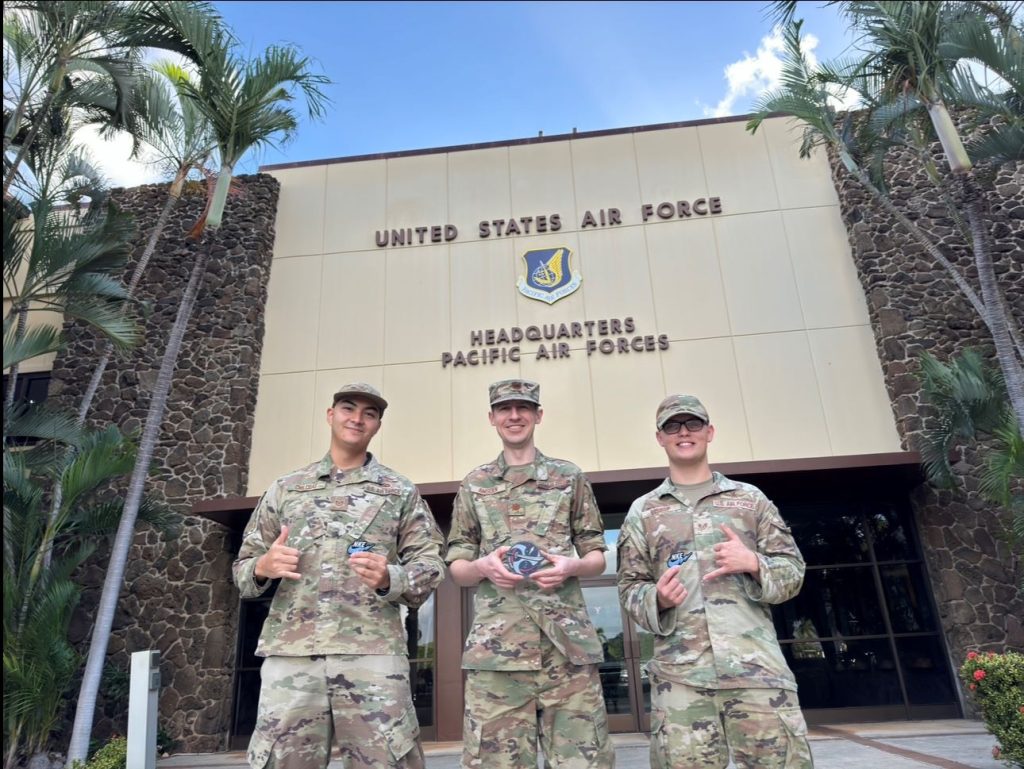Maryland Air National Guard cyber Airmen participate in Keen Edge 2024
By Master Sgt. Chris Schepers
175th Wing

Maryland Air National Guard Tech. Sgt.. Andrew Chilcoat (L), Maj. Nate Amsden, and Staff Sgt. Jeremiah Bishop, pose for a photo at Pacific Air Forces headquarters during Exercise Keen Edge 2024 at Joint Base Pearl Harbor-Hickam, Hawaii.
JOINT BASE PEARL HARBOR-HICKAM, Hawaii — Three Airmen assigned to the 175th Cyberspace Operations Group participated in Exercise Keen Edge 2024, a bilateral command post exercise with Allies February 1-8, 2024
Maryland Air National Guard Maj. Nate Amsdem, a combat plans non-kinetic coordinator, was named a superior performer for his critical synchronization of non-kinetic effects in a newly created position to reduce risk to the team. He coordinated 131 non-kinetic fires synchronizing non-kinetic effects, down to the minute, for execution in support of the Theater Joint Forces Air Component Commander.
“Seeing how the U.S. Cyber Command and U.S. Space Command were integrated at Keen Edge was refreshing because it shows how far both have come and demonstrated the capabilities available to us,” Amsden said.
Maryland Air National Guard Staff Sgt. Jeremiah Bishop, a strategy Overseas Contingency Operations planner who has supported Pacific Air Forces since last November, was recognized as an outstanding performer for performing more than 50 overseas contingency operations fires.
“I believe that exercising the synchronization of the unified and functional Combatant Commands is crucial to developing working relationships, processes, and working products for a real-world contingency or crisis event,” Bishop said. “It allows for the exercise of success and failure drills, where operational variables may be practiced in a contained environment with little to no real-world impact, as opposed to a real-world event where such issues could cause significant risk to mission and forces.”
Maryland Air National Guard Tech Sgt. Andrew Chilcoat, a non-kinetics duty technician, was also lauded for his support since March last year.
“Exercises like Keen Edge present a golden opportunity for the United States, our Allies and partners to come together and practice how we would perform during a real-world event,” said Chilcoat. “This [exercise] forces all of us to iron out command and control bottlenecks and shortfalls, and most importantly identify where we are weak and improve based on the observed and identified lessons learned.”
The Maryland Air National Guard Airmen supported the strategy division, combat plans division, and combat operations division of the Air Operations Center and contributed to the integration of over 350 notional non-kinetic effects in support of kinetic operations.
“We are very proud of our Maryland Guardsmen and their outstanding contributions to the Keen Edge 2024 exercise,” said Maryland Air National Guard Lt. Col. Christopher Quinlan, 276th Cyberspace Operations Squadron commander. “Maj. Amsden, Tech. Sgt. Chilcoat, and Staff Sgt. Bishop received glowing reviews from senior leaders for their exceptional achievements in implementing cyberspace actions into this iteration of the exercise.”
This year’s iteration of Keen Edge is the latest in a series of multinational command post exercises designed to increase integrated joint operational capability, refine command and control procedures, and enhance interoperability of all participating nations.
Air Operations Centers provide operational-level command and control of air component forces as the focal point for designing, planning, executing, and assessing air component operations.
The command post Exercise Keen Edge, and its complementary field exercise Keen Sword, are a set in a series of bilateral U.S. and Japan exercises designed to enhance interoperability between the two Allies.
“This is a true joint service exercise and really emphasizes how all of our sister services plug into the fight,” said Chilcoat. “It displays what each service can offer and how much stronger of a force we are when we put our strengths together as one cohesive unit rather than six independent services.”
